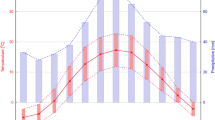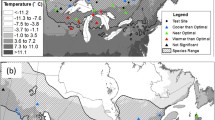Abstract
To select suitable planting stock for reforestation under uncertain future climates, information about tolerances of genotypes to different climate conditions is necessary. One useful approach is to combine dendrochronological research with common garden experiments to quantify genotype by environment interactions observed over time. Here, we assess the response of Douglas-fir provenances planted in a common environment to climate variation over five decades using tree-ring analysis and historic height data. A rare drought event that affected growth in the year of 1985 provided the opportunity to study how mature Douglas-fir provenances differ in resilience and resistance to drought conditions and whether there are trade-offs with long-term productivity. We found that overall growth performance of provenances originating from drier and colder environments within the coastal range was below average and correlated with interannual variation in temperature. Productive provenances originated primarily from moist and warm areas and their annual increments covaried strongly with summer precipitation and summer drought indices. Further, provenances with below average growth were able to recover more quickly from the drought event of 1985, but did not show stronger drought resistance than coastal sources. Our results provide evidence for trade-offs between productivity and drought resilience and show that sources originating from moist locations are more dependent on favorable growing conditions in the summer. We conclude that selecting drought-resilient planting stock as an adaptation strategy for climate change is possible, but it would entail reductions in productivity.





Similar content being viewed by others
References
Aitken SN, Whitlock MC (2013) Assisted gene flow to facilitate local adaptation to climate change. Annu Rev Ecol Evol Syst 44:367–388. doi:10.1146/annurev-ecolsys-110512-135747
Aitken SN, Yeaman S, Holliday JA et al (2008) Adaptation, migration or extirpation: climate change outcomes for tree populations. Evol Appl 1:95–111. doi:10.1111/j.1752-4571.2007.00013.x
Allen CD, Macalady AK, Chenchouni H et al (2010) A global overview of drought and heat-induced tree mortality reveals emerging climate change risks for forests. For Ecol Manag 259:660–684. doi:10.1016/j.foreco.2009.09.001
Bansal S, Harrington CA, Gould PJ, St. Clair JB (2014) Climate-related genetic variation in drought-resistance of Douglas-fir (Pseudotsuga menziesii). Glob Chang Biol 1–12. doi: 10.1111/gcb.12719
Bates D, Maechler M, Bolker B (2013) lme4: linear mixed-effects models using S4 classes. R Package version 1.0–4. http://cran.r-project.org/web/packages/lme4/index.html
Bréda N, Huc R, Granier A, Dreyer E (2006) Temperate forest trees and stands under severe drought: a review of ecophysiological responses, adaptation processes and long-term consequences. Ann For Sci 63:625–644. doi:10.1051/forest:2006042
Bunn AG (2008) A dendrochronology program library in R (dplR). Dendrochronologia 26:115–124. doi:10.1016/j.dendro.2008.01.002
Carter KK (1996) Provenance tests as indicators of growth response to climate change in 10 north temperate tree species. Can J For Res 26:1089–1095. doi:10.1139/x26-120
Chen P, Welsh C, Hamann A (2010) Geographic variation in growth response of Douglas-fir to interannual climate variability and projected climate change. Glob Chang Biol 16:3374–3385. doi:10.1111/j.1365-2486.2010.02166.x
Ching KK (1965) Early growth of Douglas-fir in a reciprocal planting. Corvallis, Or For Manag Res For Res Lab Oregon State Univ 1–20
Ching KK, Bever D (1960) Provenance study of Douglas Fir in the Pacific Northwest region. 1. Nursery performance. Silvae Genet 9:11–17
Christidis N, Jones GS, Stott PA (2014) Dramatically increasing chance of extremely hot summers since the 2003 European heatwave. Nat Clim Chang 5:3–7. doi:10.1038/nclimate2468
Dalla-Salda G, Martinez-Meier A, Cochard H, Rozenberg P (2009) Variation of wood density and hydraulic properties of Douglas-fir (Pseudotsuga menziesii (Mirb.) Franco) clones related to a heat and drought wave in France. For Ecol Manag 257:182–189. doi:10.1016/j.foreco.2008.08.019
Dalla-Salda G, Martinez-Meier A, Cochard H, Rozenberg P (2011) Genetic variation of xylem hydraulic properties shows that wood density is involved in adaptation to drought in Douglas-fir (Pseudotsuga menziesii (Mirb.)). Ann For Sci 68:747–757. doi:10.1007/s13595-011-0091-1
Domec J-C (2002) How do water transport and water storage differ in coniferous earlywood and latewood? J Exp Bot 53:2369–2379. doi:10.1093/jxb/erf100
Eilmann B, de Vries SMG, den Ouden J et al (2013) Origin matters! Difference in drought tolerance and productivity of coastal Douglas-fir (Pseudotsuga menziesii (Mirb.)) provenances. For Ecol Manag 302:133–143. doi:10.1016/j.foreco.2013.03.031
Ferrell W, Woodard E (1966) Effects of seed origin on drought resistance of Douglas-fir (Pseudotsuga menziesii) (Mirb.) Franco. Ecology 47:499–503
Fritts HC (2001) Tree rings and climate. Blackburn Press The Blackb:567. doi: 10.1038/scientificamerican0572-92
Gray LK, Hamann A (2013) Tracking suitable habitat for tree populations under climate change in western North America. Clim Chang 117:289–303. doi:10.1007/s10584-012-0548-8
Hacke UG, Sperry JS (2001) Functional and ecological xylem anatomy. Perspect Plant Ecol Evol Syst 4:97–115. doi:10.1078/1433-8319-00017
Hacke UG, Sperry JS, Pockman WT et al (2001) Trends in wood density and structure are linked to prevention of xylem implosion by negative pressure. Oecologia 126:457–461. doi:10.1007/s004420100628
Hamann A, Wang T, Spittlehouse DL, Murdock TQ (2013) A comprehensive, high-resolution database of historical and projected climate surfaces for western North America. Bull Am Meteorol Soc 94:1307–1309. doi:10.1175/BAMS-D-12-00145.1
Hartmann H (2011) Will a 385 million year-struggle for light become a struggle for water and for carbon?—How trees may cope with more frequent climate change-type drought events. Glob Chang Biol 17:642–655. doi:10.1111/j.1365-2486.2010.02248.x
Hothorn T, Bretz F, Westfall P (2008) Simultaneous inference in general parametric models. Biom J 50:346–363. doi:10.1002/bimj.200810425
Isaac-Renton MG, Roberts DR, Hamann A, Spiecker H (2014) Douglas-fir plantations in Europe: a retrospective test of assisted migration to address climate change. Glob Chang Biol 20:2607–2617. doi:10.1111/gcb.12604
Jansen K, Sohrt J, Kohnle U et al (2012) Tree ring isotopic composition, radial increment and height growth reveal provenance-specific reactions of Douglas-fir towards environmental parameters. Trees 27:37–52. doi:10.1007/s00468-012-0765-9
Kavanagh KL, Bond BJ, Aitken SN et al (1999) Shoot and root vulnerability to xylem cavitation in four populations of Douglas-fir seedlings. Tree Physiol 19:31–37. doi:10.1093/treephys/19.1.31
Kuznetsova A, Brockhoff P, Christensen R (2013) lmerTest: tests for random and fixed effects for linear mixed effect models (lmer objects of lme4 package). R package version 2.0–3
Lachenbruch B, Johnson GR, Downes GM, Evans R (2010) Relationships of density, microfibril angle, and sound velocity with stiffness and strength in mature wood of Douglas-fir. Can J For Res 40:55–64. doi:10.1139/X09-174
Lawrence WH, Rediske JH, Lawrence H (1962) Fate of sown Douglas-fir seed. For Sci 8:210–218
Leites LP, Robinson AP, Rehfeldt GE et al (2012) Height-growth response to climatic changes differs among populations of Douglas-fir: a novel analysis of historic data. Ecol Appl 22:154–165. doi:10.1890/11-0150.1
Little EL (1971) Atlas of United States trees: Vol. 1. Conifers and important hardwoods. US Dep Agric Misc Publ 1146 1–877
Lloret F, Keeling EG, Sala A (2011) Components of tree resilience: effects of successive low-growth episodes in old ponderosa pine forests. Oikos 120:1909–1920. doi:10.1111/j.1600-0706.2011.19372.x
Loarie SR, Duffy PB, Hamilton H et al (2009) The velocity of climate change. Nature 462:1052–1055. doi:10.1038/nature08649
Martinez-Meier A, Sanchez L, Pastorino M et al (2008) What is hot in tree rings? The wood density of surviving Douglas-firs to the 2003 drought and heat wave. For Ecol Manag 256:837–843. doi:10.1016/j.foreco.2008.05.041
Mátyás C (1996) Climatic adaptation of trees: rediscovering provenance tests. Euphytica 92:45–54. doi:10.1007/BF00022827
Mayr S, Hacke U, Schmid P et al (2006) Frost drought in conifers at the alpine timberline: xylem dysfunction and adaptations. Ecology 87:3175–3185. doi:10.1890/0012-9658(2006)87[3175:FDICAT]2.0.CO;2
Mote PW, Salathé EP (2010) Future climate in the Pacific Northwest. Clim Chang 102:29–50. doi:10.1007/s10584-010-9848-z
Nilsson L-O, Wiklund K (1992) Influence of nutrient and water stress on Norway spruce production in south Sweden ? The role of air pollutants. Plant Soil 147:251–265. doi:10.1007/BF00029077
Pharis RP, Ferrell WK (1966) Differences in drought resistance between coastal and inland sources of Douglas-fir. Can J Bot 44:1651–1659. doi:10.1139/b66-177
R Core Team (2013) R: A language and environment for statistical computing. R Foundation for Statistical Computing, Vienna, Austria. http://www.R-project.org/
Regent Instruments Canada Inc. (2012) WinDendro for tree-ring analysis WinDendro Reference Manual, Version 2012b, June 27, 2012. Regent Instruments Inc, Québec, Canada
Rehfeldt GE, Ying CC, Spittlehouse DL, Hamilton DA (1999) Genetic responses to climate in Pinus contorta: niche breadth, climate change, and reforestation. Ecol Monogr 69:375. doi:10.2307/2657162
Rehfeldt GE, Leites LP, Bradley St. Clair J et al (2014) Comparative genetic responses to climate in the varieties of Pinus ponderosa and Pseudotsuga menziesii: clines in growth potential. For Ecol Manag 324:138–146. doi:10.1016/j.foreco.2014.02.041
Ricciardi A, Simberloff D (2009) Assisted colonization is not a viable conservation strategy. Trends Ecol Evol 24:248–253. doi:10.1016/j.tree.2008.12.006
Schmidtling RC (1994) Use of provenance tests to predict response to climate change: loblolly pine and Norway spruce. Tree Physiol 14:805–817. doi:10.1093/treephys/14.7-8-9.805
Schreiber SG, Hacke UG, Hamann A, Thomas BR (2011) Genetic variation of hydraulic and wood anatomical traits in hybrid poplar and trembling aspen. New Phytol 190:150–160. doi:10.1111/j.1469-8137.2010.03594.x
Schreiber SG, Ding C, Hamann A et al (2013) Frost hardiness vs. growth performance in trembling aspen: an experimental test of assisted migration. J Appl Ecol 50:939–949. doi:10.1111/1365-2664.12102
St. Clair JB, Howe GT (2007) Genetic maladaptation of coastal Douglas-fir seedlings to future climates. Glob Chang Biol 13:1441–1454. doi:10.1111/j.1365-2486.2007.01385.x
St. Clair JB, Mandel NL, Vance-Borland KW (2005) Genecology of Douglas fir in western Oregon and Washington. Ann Bot 96:1199–1214. doi:10.1093/aob/mci278
Valladares F, Gianoli E, Gómez JM (2007) Ecological limits to plant phenotypic plasticity. New Phytol 176:749–763. doi:10.1111/j.1469-8137.2007.02275.x
Wang T, Hamann A, Yanchuk A et al (2006) Use of response functions in selecting lodgepole pine populations for future climates. Glob Chang Biol 12:2404–2416. doi:10.1111/j.1365-2486.2006.01271.x
White T, Ching K (1985) Provenance study of Douglas-fir in the Pacific Northwest Region IV. Field performance at age 25 years. Silvae Genet 34:84–90
Wickham H (2011) ggplot2. Wiley Interdiscip Rev Comput Stat 3:180–185. doi:10.1002/wics.147
Wigley TML, Briffa KR, Jones PD (1984) On the average value of correlated time series, with applications in dendroclimatology and hydrometeorology. J Clim Appl Meteorol 23:201–213. doi:10.1175/1520-0450(1984)023<0201:OTAVOC>2.0.CO;2
Wykoff RW, Crookston NL, Stage AR (1982) User’s guide to the stand prognosis model. USDA For. Serv., GTR-INT-133, p. 112
Acknowledgments
The authors are very thankful to Ionut Aron of the Malcolm Knapp Research Forest and Bruce Larson of the University of British Columbia for support with research logistics. They are also very grateful for Miriam Isaac-Renton’s comments and Anja Litka’s field assistance. David Montwé is supported by scholarship funds from the State Graduate Funding Program of Baden-Württemberg. Two anonymous reviewers helped to improve an earlier version of this manuscript.
Conflict of interest
The authors declare that they have no conflict of interest.
Data archiving statement
Height and diameter data is available from the Center of Forest Provenance Data ( http://cenforgen.forestry.oregonstate.edu/retrieve/DataRetrieve.php?study_id=1 ). Tree-ring, height and diameter data is made available as an electronic supplement to this publication (Montwe_et_al_2015_TGGE.xlsx).
Author information
Authors and Affiliations
Corresponding author
Additional information
Communicated by J. Beaulieu
Electronic Supplementary Material
Rights and permissions
About this article
Cite this article
Montwé, D., Spiecker, H. & Hamann, A. Five decades of growth in a genetic field trial of Douglas-fir reveal trade-offs between productivity and drought tolerance. Tree Genetics & Genomes 11, 29 (2015). https://doi.org/10.1007/s11295-015-0854-1
Received:
Revised:
Accepted:
Published:
DOI: https://doi.org/10.1007/s11295-015-0854-1




